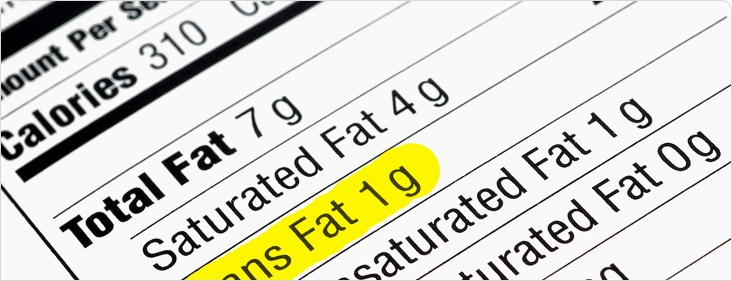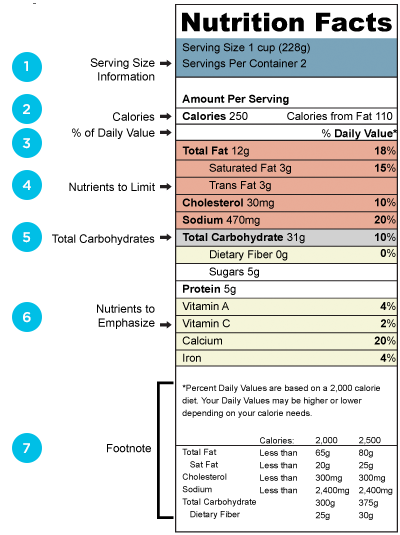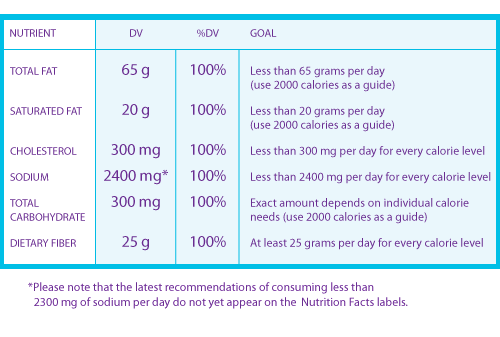
Food Labels
When it comes to nutrition labels, sometimes what you read isn't what you get
READING NUTRITION LABELS
A Nutrition Facts label can be found on the side panel of most food packages. The title “Nutrition Facts” lets you know that the label meets federal regulations. The top part gives information about the food in the package, including serving size, total calories, calories from fat, and other information that varies by food product. The bottom part of the label is called a footnote; it appears only on larger packages and gives general information about how much the body needs of some nutrients. Let’s take a closer look at a Nutrition Facts label.

- Serving size information: Pay attention to the serving size, including the total number of servings in the food package. The size of the serving listed on the food label determines the nutrient amounts listed on the remainder of the label. If you eat a portion size different than the one indicated, you should calculate the values of the nutrients to determine what you have consumed.
- Calories: The calories listed on the label are for one serving. Make sure you understand how many servings are in the entire food package. If you eat a serving size different than the one indicated, you should calculate the calories you have consumed. For example, 8 ounces of milk is one serving and provides 90 calories. If you drink 16 ounces of milk (2 servings), multiply 90 calories by 2, which means you have consumed a total of 180 calories.
- % of daily value: The % DV is based on recommendations for a 2000-calorie diet. For labeling purposes, the FDA set 2000 calories as the reference amount for calculating % DV. You may require more or less than 2000 calories per day as an individual.
- Nutrients to limit: Eating too much fat, saturated fat, trans fat, and cholesterol may increase your risk of many diseases including heart disease and cancer. In addition, excess sodium intake can worsen hypertension (high blood pressure) in sensitive individuals and should be limited in the general population to avoid future chronic diseases. Look at the percentage of Daily Value (% DV) column to get an idea of how much of these nutrients a food contains. If the % DV is greater than 20%, the food is considered “high” in that nutrient while 5% or less is considered “low.”
- Total carbohydrates: The % DV for total carbohydrates is based on a general guideline that a 2000-calorie diet should contain 300 grams of carbohydrates. You may require more or less than this amount. The % DV shows you how much of the recommended daily amount of a nutrient is in a serving of food. By using the % DV, you can tell if this amount is high or low. If the % DV is greater than 20%, the food is considered “high” in that nutrient while 5% or less is considered “low.” The % DV of the Nutrition Facts panel tells you whether the nutrients in a serving of food contribute a lot or a little to your total daily intake. The chart below details the DVs and % DVs for a 2000 calorie diet.

- Nutrients to emphasize: Most people do not consume an adequate amount of fiber, iron, calcium, and vitamins A and C. Look at the food label to identify foods that contain high amounts of these nutrients. Look at the % DV column to get an idea of how much of these nutrients a food contains.
- Footnote: You may have noticed that there is an asterisk (*) after the words “% Daily Value.” This asterisk means that the values are based on a 2000-calorie diet. This statement must appear on all food labels. The footnote section remains the same for every package because it is not based on the actual food in the package but simply shows the recommended dietary advice for Americans based on a 2000- and 2500-calorie diet.
HOW ACCURATE ARE FOOD LABELS ON PREPARED MEALS?
Reading the nutritional information about the food you eat is important, but you may not want to believe everything you read. If the information on a food label seems too good to be true, it may be so!
Commercially prepared foods may have more calories than what the label says. In one study, 10 frozen meals were tested; the results showed that calorie contents averaged 8% more than what was stated on the labels. Furthermore, the calorie contents of 29 quick-serve and sit-down restaurant foods averaged 18% more than what the label said, and some foods had 200% more calories!
What can this mean for you? It can be frustrating that calorie counts are not always accurate. However, now that you’ve started to learn about appropriate serving sizes and how many calories are in common foods, you can use this information to determine the approximate calorie content of restaurant meals.
Here’s a practical example. Diane is at a sandwich shop to buy a turkey sub. The menu says a turkey sub with lettuce, tomato, and onion is 280 calories. Diane thinks this makes sense based on what she knows about the calories in turkey, bread, and vegetables. Along with the unsweetened iced tea and apple back at her desk, Diane thinks the turkey sandwich will make a good lunch.
When Diane gets her sub, it’s much larger than she expected; it seems to have about 10 slices of turkey. Diane knows from using her food planner and tracker that a thin slice of turkey has about 20 calories. This sub has 200 calories in the turkey alone. so the estimate of a total of 280 calories may not be realistic. Have you been in a situation like this? It’s important to stay alert when ordering food. Added mayonnaise, cheese, or other condiments can also add calories.
What can you do about it?
- Read the "fine print" in the menu. What does the calorie count include? The menus often show pictures of foods with side dishes and drinks, but give a calorie count for the entrée only
- When you place your order, be specific. If you don’t want mayonnaise or cheese, say so! Consider ordering condiments and dressings on the side and then use just a small amount
- When you get your meal and see that it’s bigger than you thought it would be, take some home for later or offer to share with a friend
Eating out is convenient and fun, but consider what you are ordering. Start with a healthy order in line with your healthcare provider's recommendations and then make sure you got what you expected. You may be getting more than you asked for!
